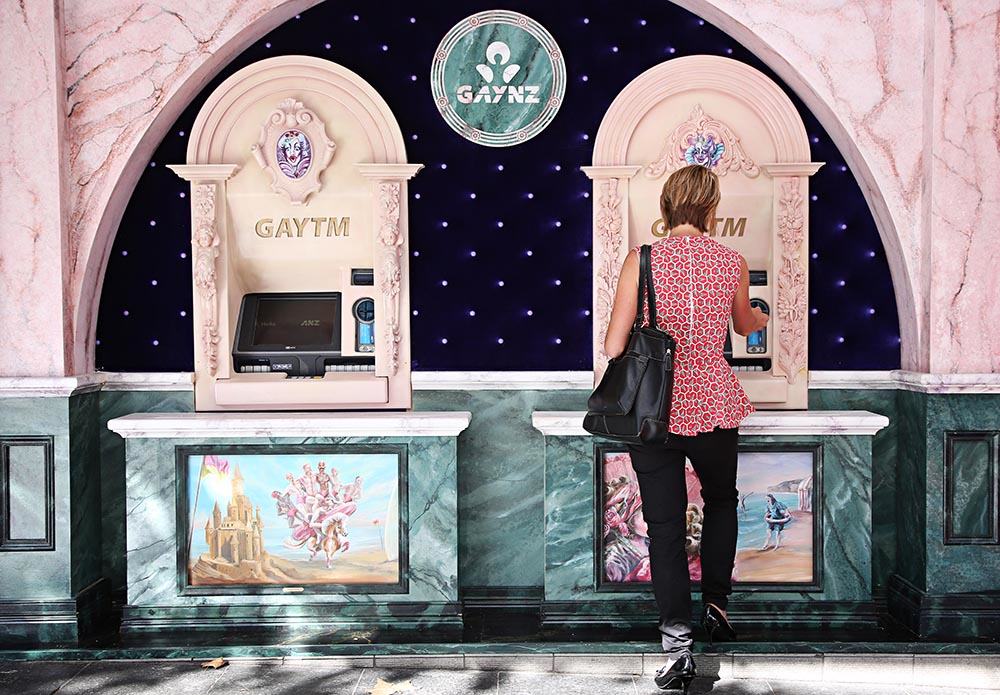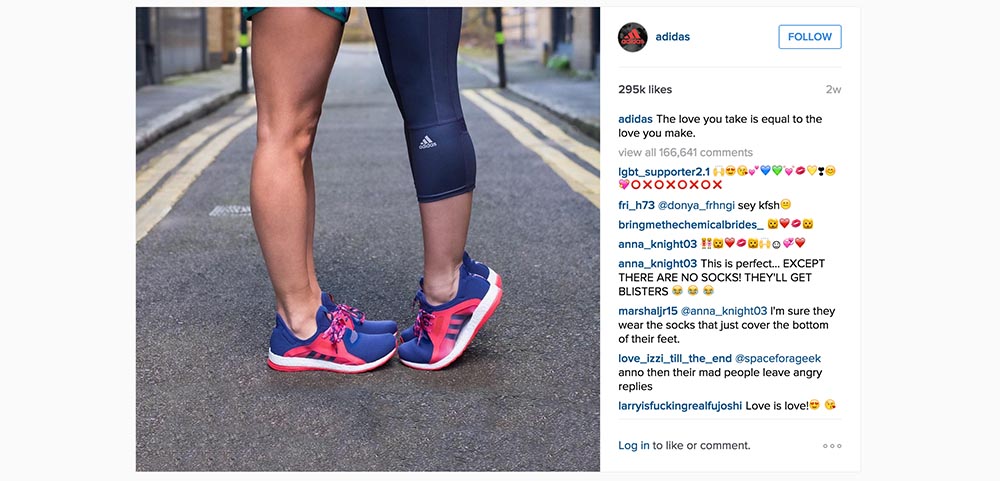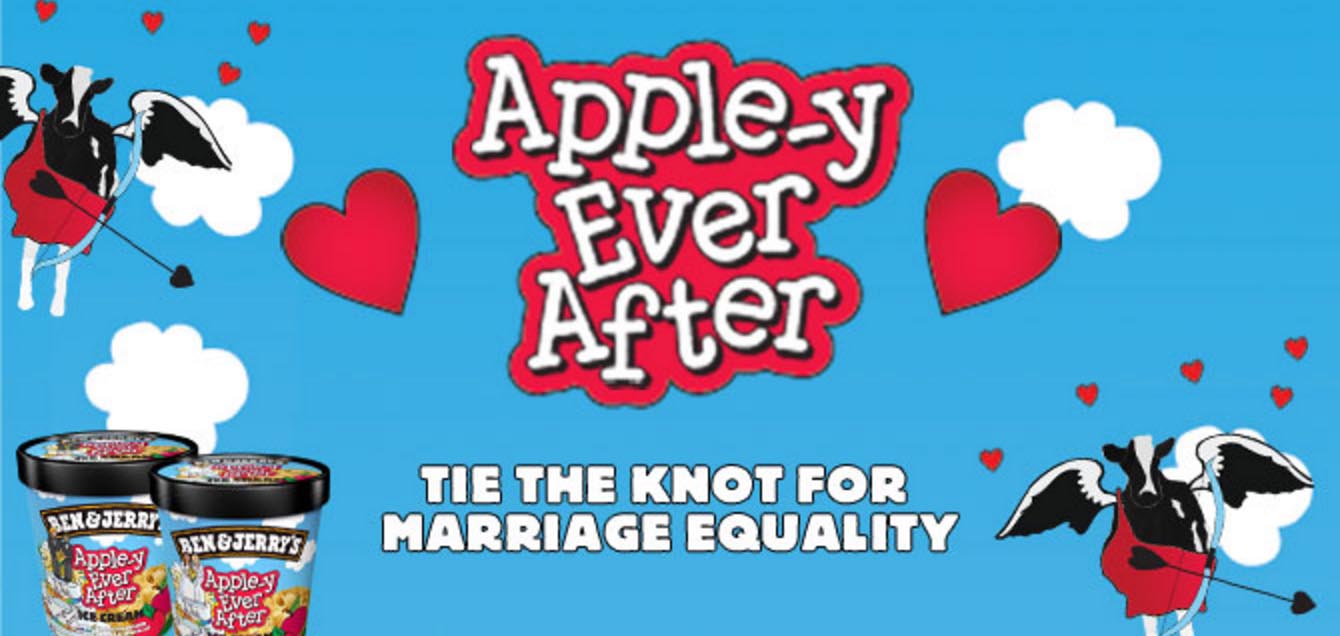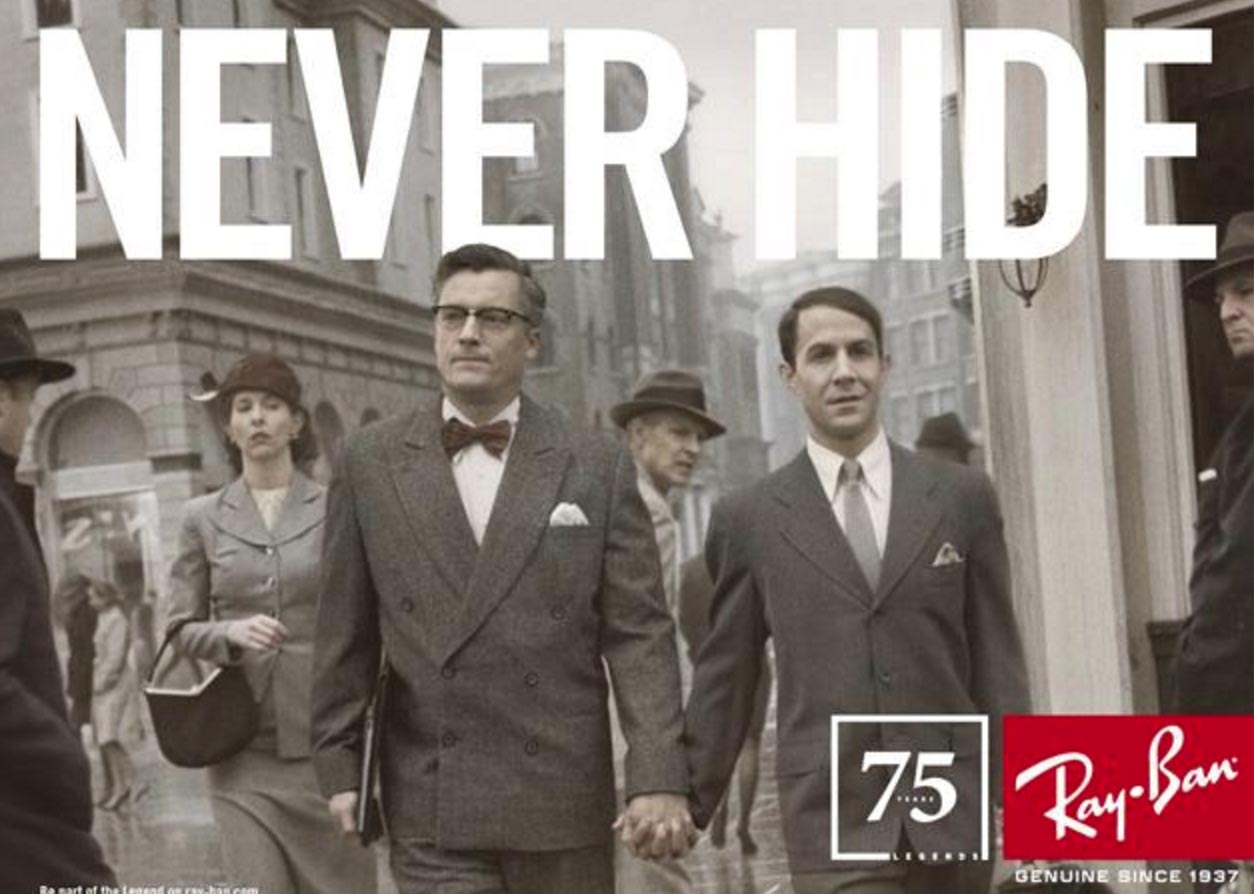How big brands are bringing same-sex couples into the mainstream
By Rosie Pentreath
Sydney’s Gay and Lesbian Mardi Gras is in full swing and, as ever, big brands are getting in on the action with colourful local advertising campaigns.
Mardi Gras partner Medibank has pasted posters illustrated with Fair Day photographs all over town; AirBnB enlisted legendary Sydney drag queen Verushka Darling to launch its ‘Host With Pride’ Mardi Gras campaign; and ANZ Banking Group has rebranded as GayNZ for the festivities, transforming its Darlinghurst branch into a gay wonderland and choosing to wave our beautiful rainbow flag in a special Twitter Hashflag – Australia’s first ever branded one – to celebrate ten years as official Mardi Gras partner.
International gay events like Mardi Gras aren’t the only things that entice big brands to appear to rally for the cause. Brands have been chasing the pink dollar – and supposedly championing diversity – for years, usually to promote LGBTQI-specific products, but more recently in mainstream advertising. It’s a trend that’s growing, according to market research conducted by Buzzfeed, who looked at the increase of appearances by same-sex couples in multi-million dollar marketing campaigns, citing brands’ desires to reflect the diversity of society and positively concluding that the majority of Americans agreed ads depicting same-sex couples correctly reflect society.
But do brands really care about diversity? Or are they just trying to make a quick buck?
Speaking to Buzzfeed, a Professor of Marketing at San Francisco State University described big brands’ attempts to bring same-sex couples to mainstream advertising as “a really smart strategy”, going on to say: “I started reading comments on Facebook and Twitter [about Honey Maid’s 2014 campaign featuring a same-sex couple] and overwhelmingly the comments were positive. I read tweet after tweet where the person said, ‘I haven’t bought graham crackers in a long time, but I’m going to go out and buy Honey Maid graham crackers.’
Mission accomplished.”
Jumping on the diversity bandwagon is good for sales figures, which is fine – we can’t escape the fact we live in a society governed by brands and advertising – but it doesn’t seem quite right if nothing changes significantly in the struggle for gay rights (and the rights of other minority groups). Whilst conglomerates are turning a giant profit in the name of diversity, queer people like us are being attacked and murdered, and we gays still can’t marry our loved ones in Australia.
We still have a long way to go.
Talking about queer issues when Gay Pride is in full swing or Mardi Gras is bringing thousands of people from all over the world together for a couple of weeks isn’t the same as promoting real, long-lasting change. Brands have to be careful not to seem to be exploiting us and our issues to their own end.
Moreover, it could even be damaging to the queer community as it commoditises and ghettoises us into the applied stereotypes that have historically prevented us from being embraced. Whilst ANZ’s sexed-up Darlinghurst branch champions a wonderfully positive message, it is also a physical space that haters can (and no doubt will) choose to avoid so as not to mix with us.
One space where brands are better at convincing us they really care is the online social space. More Australians are coming out on Facebook than ever before and Facebook’s 2015 Celebrate Pride profile picture filter afforded the fight for gay rights significant airtime in mainstream culture. That year, marriage equality was the sixth most talked about topic on Facebook globally and the eleventh most talked about topic in Australia, according to Facebook itself.
In terms of advertising, brands can get away with being much “braver” on social media, working as they are with a much more human platform than television or billboard advertising, say.
This year, Adidas featured a same-sex couple in a Valentine’s Day Instagram post that has been liked by nearly 300,000 people to date. When homophobic users initially voiced their disgust at Adidas’s inclusion of a same-sex pair, the brand was quick to respond with: “No. This day is for LOVE.”
And when Campbell Soup Company launched their 2015 TV advert depicting gay dads feeding their son Star Wars Soup, some genius responded to homophobic reception on Facebook with a parody Campbell’s account standing up for gay rights.
With social media community managers making the effort to respond to negative comments faster than ever, brands are coming across as more human than they have ever been, unafraid to engage in debate and in their own way help pave the way for a world in which homophobia is simply not tolerated in public.
So despite fears that we may be being exploited or misrepresented in advertising, we can all agree that any exposure afforded to same-sex couples can only be a good thing, even if it is a thinly veiled profit-turning sideshow for a megacorporation. It gives us exposure; it gives us a voice. And it is a trend that looks set to stay.
To celebrate, here are nine of our faves.
ANZ

In honour of Mardi Gras this year, ANZ has rebranded itself as “GayNZ”, redesigned its Darlinghurst branch as a queer wonderland and activated a #GayNZ Hashflag on Twitter. Not only is it Australia’s first branded Hashflag, but it’s also the only LGBTQI-themed flag currently active and, as far as we can see from the official Hashflag list, one of only a few queer-themed flags to make the cut, #Pride2015 and #LoveWins being among the others. Go ANZ!
Campbell’s
The force is well and truly with the gay dads featured in Campbell Soup Company’s 2015 ad for Star Wars Soup. “I am your father.” “No no no, I am your father.” We like what you did there, Campbell’s…
Adidas
To mark Valentine’s Day this year, Adidas promoted universal love on its Instagram account. Instead of opting for the depiction of heterosexual love generally favoured by brands, Adidas showed us two women more-than-likely kissing and even responded to homophobic comments quickly as they piled up under the photo.
Lynx
When Lynx featured a gay kiss that lasts all of one whole second in its 2015 TV ad for hair gel, it became the seventh most complained about commercial in Australia that year. Seriously? This guy’s running around doing all manner of cray cray things (include fleeing from an explosion he may or may not have caused) and it was that little kiss they chose to complain about? If you blink you miss it. The Aussie Advertising Standards Bureau dismissed the complaints, saying the kiss is “over the top” but not offensive.
Natwest
Natwest Bank in the UK ran a rather sweet campaign featuring twin sisters in 2013. In a TV ad promoting the bank’s Cashback Plus Rewards scheme, the lives of the twins are compared and contrasted, with one saying “I love my husband Jeff” while the other says “I love my girlfriend Kate.” It’s an example where the brand is not really in your face about the whole thing and we love that.
Coca-Cola
It’s estimated that adverts aired during Super Bowl halftime are viewed by upwards of 115,000 people these days – that’s a third of the population of the US. In 2014, soft drink giant Coca-Cola used the spot to air an ad featuring gay dads ice-skating with their daughter among other diversity-promoting images. Sweet.
Ben & Jerry’s
Ben & Jerry’s was all about the love when it unveiled its “Appley Ever After” flavour and campaign in 2013 to coincide with the UK government’s debate on same-sex marriage (which was passed in May that year and made law by May 2014 – come on Australia, it’s our turn!). It’s not the first time our chilled-out friends have supported the gay community: in 2009 they renamed their ‘Chubby Hubby’ flavour ‘Hubby Hubby’ in celebration of gay marriage legislation passed in their Vermont home.
Ray-Ban
What could be more appropriate for a campaign titled “Never Hide” than an out gay couple? Sunglasses retailer Ray-Ban must have thought the same thing when they included a same-sex couple among the line up in their ongoing Never Hide campaign in 2012.
Ikea
In typical cool Scandi style, Ikea featured a same-sex couple in a TV ad as far back as 1994, way before anyone else had thought of it. The ad, which is for living room furniture, featured a gay couple admiring Ikea products and was aired after hours in New York, Philadelphia and Washington. The pioneering move resulted in uproar from conservatives, with some people calling for a boycott of Ikea stores in the States.





